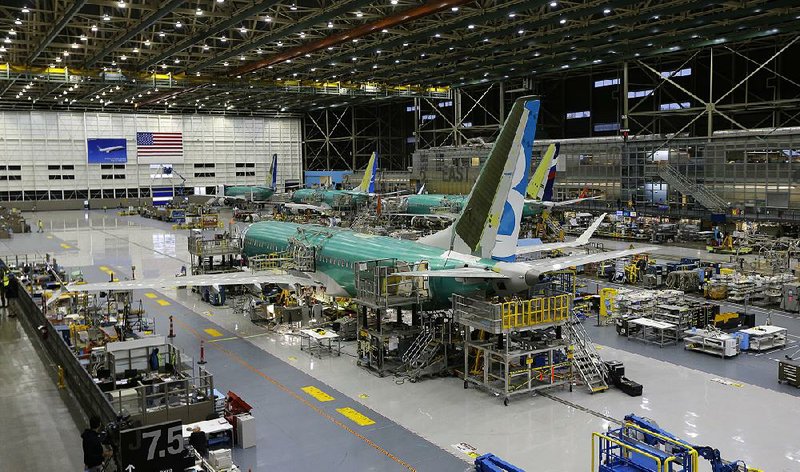WASHINGTON -- Shopping tapered off toward the end of the Christmas season, while lower gasoline prices cut into overall retail sales in December, the Commerce Department said Friday.
Retail sales dipped a seasonally adjusted 0.1 percent last month to $448.1 billion after having climbed a solid 0.4 percent in November.
The report was one of three Friday that analysts watched closely. The Federal Reserve said U.S. industrial production dropped for the third-straight month in December, and the Labor Department said U.S. wholesale prices fell slightly, reflecting a big drop in energy prices.
Friday's retail sales report shows consumer tastes shifting toward restaurants and online shopping. The extra savings from falling gasoline prices have yet to fuel large spending gains in other retail categories. Still, some economists viewed the sales data as a positive reflection of the 2.9 million jobs added in 2015.
"There isn't anything encouraging in this report," said Thomas Simons, a money-market economist at Jefferies Group LLC in New York. "It's very disappointing. The labor market is in good shape, which suggests the outlook is probably better than this."
Sales fell in December at clothing and electronics outlets and general merchandise stores. But those declines were largely offset by spending at restaurants, online retailers, furnishers, and sporting goods and building supply stores.
Bricklin Dwyer, an economist at the bank BNP Paribas, suggested that an unusually warm December likely hurt clothing store sales and encouraged spending on building supplies. He said he expects these trends to reverse as the weather has turned colder in January.
The main drag on retail sales remains lower prices at the pump. Sales at gas stations, which aren't adjusted for changes in price in the government report, fell 1.1 percent in December. Gasoline prices have continued to fall with the start of 2016. Oil is hovering around $30 a barrel, and many analysts expect the price to decline further.
Cheap gasoline has freed up cash in many household budgets. The average price of gasoline fell below $2 a gallon this week for the first time since March 2009, according to the Energy Department. The average household has an additional $660 to spend this year because of cheaper fuel, according to the government.
This appears to have provided a modest boost to retailers. Excluding gas, retail sales were unchanged last month and advanced 3.9 percent from a year ago. Much of the gain has been concentrated at auto dealers and restaurants.
Sales at auto dealers revved up just 0.1 percent in December but posted a 6.3 percent annual gain. For 2015, U.S. auto sales hit a record high of 17.47 million, topping the prior record of 17.35 million set in 2000, according to industry reports.
Restaurants and bars have also profited. Spending at those businesses climbed 6.5 percent from a year ago.
Economists watch the retail sales report closely because it provides the first indication each month of the willingness of Americans to spend. Consumer spending drives about 70 percent of the economy. Yet retail sales account for only about one-third of spending, with services such as haircuts and Internet access making up the remaining two-thirds.
U.S. industrial production dropped for the third-straight month in December, as utilities reduced output amid unusually warm weather and energy companies cut back in the face of falling oil prices.
Industrial production, which includes manufacturing, mining and utilities, contracted 0.4 percent after retreating a revised 0.9 percent the previous month, the Federal Reserve reported Friday.
American industry has struggled in recent months even as the overall economy appears solid. The November decline was the biggest drop since May 2009. Output fell 0.2 percent in October and was flat in September; the Fed originally reported that production fell in September.
"Overall, with the dollar still rising at a rapid pace and global demand clearly pretty weak we don't expect much from the U.S. manufacturing sector this year," Paul Ashworth, chief U.S. economist at Capital Economics, wrote in a research report. "We still expect the domestic service-based economy to perform well this year."
U.S. producer prices fell slightly in December, reflecting a big drop in energy prices. The decline capped a year in which prices at the wholesale level fell.
The Labor Department said Friday that its Producer Price Index, which measures inflation before it reaches consumers, dropped 0.2 percent in December after a 0.3 percent increase in November. Over the past 12 months, producer prices have declined 1 percent.
Core inflation, which excludes volatile food and energy costs, edged up a slight 0.1 percent in December. For the past 12 months, core inflation at the wholesale level is up a scant 0.3 percent.
Information for this article was contributed by Josh Boak and Paul Wiseman and Martin Crutsinger of The Associated Press and Shobhana Chandra of Bloomberg News.
Business on 01/16/2016
